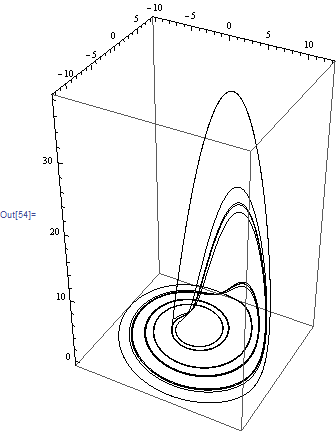Update May 3, 2022: Added c, i, j as local variables
Update Mar 12, 2022: Fixed mistake in implementation of PlotExponents
Update Apr 27, 2020: Got rid of AppendTo and added PlotExponents and PlotOpts options.
Update Nov 6, 2018: Tweaked to work on nonautonomous systems, to fix problem reported here.
Here's an updated implementation (works with MMA v11) that generalizes Housam Binous & Nasri Zakia's update to Marco Sandri's package and incorporates ideas from @bbgodfrey. The main advantage is that it uses NDSolve rather than Euler's method for solving the differential equations, so it should be more accurate / faster than Sandri's implementation.
First, define @halirutan's GramSchmidt:
GramSchmidt[w_?MatrixQ] := Module[{v = ConstantArray[0, Length[w]]},
Table[v[[n]] = w[[n]] - Sum[(v[[i]].w[[n]]/v[[i]].v[[i]])*v[[i]], {i, n - 1}], {n, Length[w]}];
v]
Then the main function:
LyapunovExponents[eqnsin_List, icsin : ({__Rule} | _Association), nlein_Integer: 0, opts___?OptionQ] := Module[{
(* options *)
tstep, maxsteps, ndsolveopts, logbase, showplot, plotexponents, plotopts,
(* iterators *)
c, i, j,
(* other variables *)
δ, neq, nle, vars, rhs, jac, eqns, unks, ics, cum, res, edat, state, newstate, sol, W, norms},
(* parse options *)
tstep = Evaluate[TStep /. Flatten[{opts, Options[LyapunovExponents]}]];
maxsteps = Evaluate[MaxSteps /. Flatten[{opts, Options[LyapunovExponents]}]];
ndsolveopts = Evaluate[NDSolveOpts /. Flatten[{opts, Options[LyapunovExponents]}]];
logbase =Evaluate[LogBase /. Flatten[{opts, Options[LyapunovExponents]}]];
showplot = Evaluate[ShowPlot /. Flatten[{opts, Options[LyapunovExponents]}]];
plotexponents = Evaluate[PlotExponents /. Flatten[{opts, Options[LyapunovExponents]}]];
plotopts = Evaluate[PlotOpts /. Flatten[{opts, Options[LyapunovExponents]}]];
neq = Length[eqnsin];
If[nlein == 0, nle = neq, nle = nlein]; (* how many exponents *)
(* extract vars and right hand sides from eqnsin *)
vars = eqnsin[[All, 1, 0, 1]];
rhs = eqnsin[[All, 2]];
(* jacobian matrix *)
jac = D[rhs, {Replace[vars, {x_ -> x[t]}, 1]}];
eqns = Join[
eqnsin,
Flatten[Table[δ[i, j]'[t] == (jac.Table[δ[i, j][t], {i, neq}])[[i]], {j, nle}, {i, neq}]]
];
unks = Join[
vars,
Flatten[Table[δ[i, j], {j, nle}, {i, neq}]]
];
ics = Join[
Table[var[0] == (var /. icsin), {var, vars}],
Flatten[Table[δ[i, j][0] == IdentityMatrix[neq][[i, j]], {j, nle}, {i, neq}]]
];
cum = Table[0, {nle}];
state = First@NDSolve`ProcessEquations[Flatten[Join[eqns, ics]], unks, t, Evaluate[Sequence @@ ndsolveopts]];
(* main loop *)
edat = Table[
newstate = First@NDSolve`Reinitialize[state, ics];
NDSolve`Iterate[newstate, c tstep];
sol = NDSolve`ProcessSolutions[newstate];
W = GramSchmidt[Evaluate[Table[δ[i, j][c tstep], {j, nle}, {i, neq}] /. sol]];
norms = Map[Norm, W];
(* update running vector magnitudes *)
cum = cum + Log[logbase, norms];
ics = Join[
Table[var[c tstep] == (var[c tstep] /. sol), {var, vars}],
Flatten[Table[δ[i, j][c tstep] == (W/norms)[[j, i]], {j, nle}, {i, neq}]]
];
cum/(c tstep)
, {c, maxsteps}];
If[showplot, Print[ListPlot[Transpose[edat][[1 ;; plotexponents]], Evaluate[Sequence @@ plotopts]]]];
Return[cum/(maxsteps tstep)]
];
Options[LyapunovExponents] = {NDSolveOpts -> {}, TStep -> 1, MaxSteps -> 10^4, LogBase -> E,
ShowPlot -> False, PlotExponents -> 1, PlotOpts -> {}};
Now, onto the Rössler system. Note, the constant 0.1 in OP's equations should be 0.2 to match Sprott's results (otherwise the system is not chaotic). Let's look at the attractor.
eqns = {x'[t] == -(y[t] + z[t]), y'[t] == x[t] + 0.2 y[t],
z'[t] == 0.2 + z[t] (x[t] - 5.7)};
sol = NDSolve[{eqns, {x[0] == 1, y[0] == 1, z[0] == 1}}, {x, y, z}, {t, 0, 1000}][[1]];
ParametricPlot3D[{x[t], y[t], z[t]} /. sol, {t, 900, 1000}, PlotRange -> All]

Now, use the final values to start LyapunovExponents.
ics = {x -> 0.785, y -> -4.34, z -> 0.036};
LyapunovExponents[eqns, ics, ShowPlot -> True]

(* {0.0710707, 0.000384542, -5.39372} *)
Pretty close to Sprott's values of {0.0714, 0, -5.3943} as referenced by @Nasser. If we want more accuracy, just increase MaxSteps.
LyapunovExponents[eqns, ics, ShowPlot -> True, MaxSteps -> 10^5]

(* {0.071127, 0.0000389742, -5.39419} *)
References:
Sandri M (1996) Numerical calculation of Lyapunov exponents. The Mathematica Journal 6:78–84. https://library.wolfram.com/infocenter/Articles/2902/
Wolf A, Swift JB, Swinney HL, Vastano JA (1985) Determining Lyapunov exponents from a time series. Physica D: Nonlinear Phenomena 16:285–317. https://doi.org/10.1016/0167-2789(85)90011-9






{ }icon). $\endgroup$